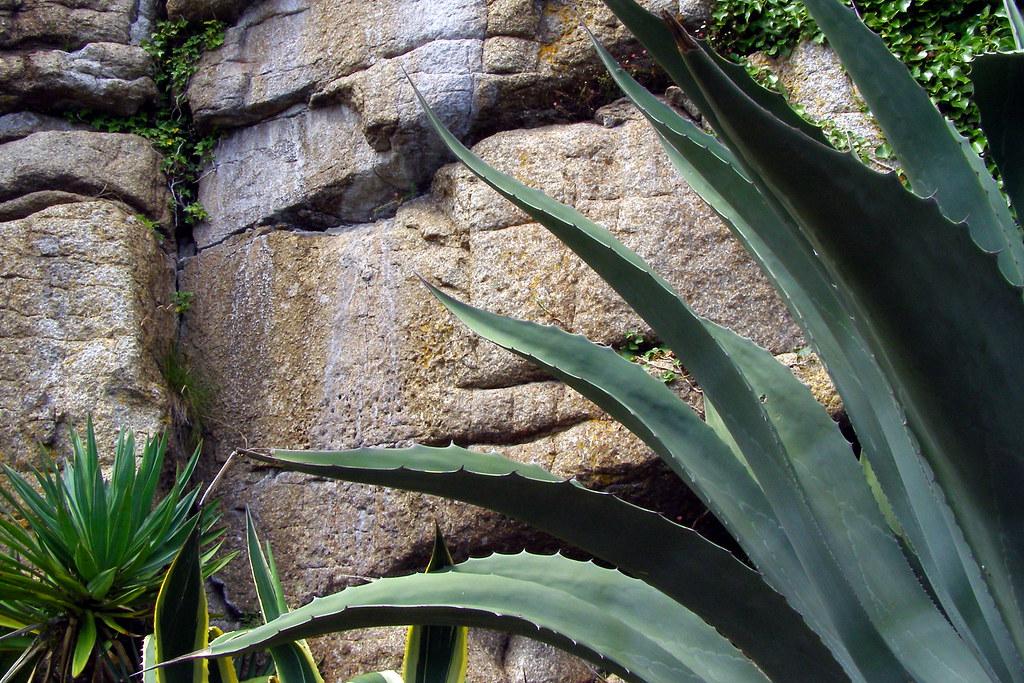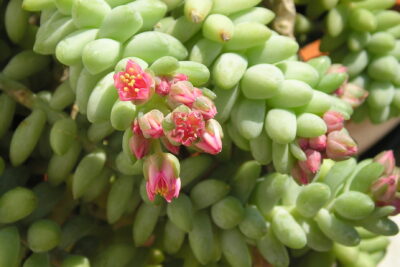
Spiky Succulents: A Guide to Thorny and Spiky Types

Succulents have become incredibly popular houseplants and garden additions in recent years. Known for their ability to store water in their leaves, these plants are highly adaptable and easy to care for. While many succulents have smooth and fleshy leaves, there is a whole group of succulents that stand out with their thorny and spiky appearance. These spiky succulents not only add an interesting texture to any plant collection, but they also have unique characteristics that make them stand out from their smooth-leaved counterparts.
We will take a closer look at spiky succulents and explore some of the most popular varieties. We will discuss the different types of spiky succulents, their care requirements, and how to best showcase their prickly beauty. Additionally, we will provide tips on how to propagate and propagate these succulents, as well as common challenges and how to overcome them. Whether you are a succulent enthusiast looking to expand your collection or a beginner wanting to learn more about these fascinating plants, this guide will provide you with the knowledge and inspiration to incorporate spiky succulents into your green space.
- Choose succulents with thorns and spikes for added texture in your garden
- Plant spiky succulents in well-draining soil to prevent root rot
- Water spiky succulents sparingly to avoid overwatering and promote healthy growth
- Use gloves when handling thorny succulents to protect your hands
- Place spiky succulents in a sunny spot to ensure proper growth and vibrant colors
- Incorporate spiky succulents in rock gardens or xeriscapes for a low-maintenance and visually appealing landscape
- Prune thorny succulents regularly to maintain their shape and prevent overcrowding
- Combine spiky succulents with softer, leafy plants for a contrasting and balanced arrangement
- Research specific spiky succulent varieties to find ones that best suit your climate and care preferences
- Enjoy the unique and striking beauty that spiky succulents bring to your indoor or outdoor space
- Frequently Asked Questions
Choose succulents with thorns and spikes for added texture in your garden
If you're looking to add some unique texture and visual interest to your garden, consider incorporating succulents with thorns and spikes. These spiky plants not only add a touch of drama and intrigue to your outdoor space, but they also have their own set of advantages.
The Benefits of Spiky Succulents
Succulents with thorns and spikes offer a range of benefits that make them a popular choice among garden enthusiasts:
- Deter pests: The sharp spikes and thorns act as a natural deterrent to pests, helping to keep your garden protected.
- Low maintenance: Like other succulents, spiky varieties are known for their ability to thrive in dry conditions, making them low maintenance and perfect for busy gardeners.
- Drought tolerance: Spiky succulents have adapted to survive in arid climates, making them highly drought-tolerant and resilient.
- Unique aesthetics: The sharp and spiky textures of these succulents create a visually striking contrast to softer, smoother plants, adding depth and interest to your garden.
Popular Spiky Succulent Varieties
Here are some popular spiky succulents that you can consider adding to your collection:
- Euphorbia tirucalli (Pencil Cactus): This succulent features long, slender stems covered in tiny thorns, resembling a cluster of pencils.
- Agave americana (Century Plant): Known for its large size and sharp, spiky leaves, this agave variety adds a bold presence to any garden.
- Aloe polyphylla (Spiral Aloe): With its unique spiral growth pattern and spiky rosette of leaves, this succulent is a true showstopper.
- Opuntia (Prickly Pear Cactus): This cactus variety is characterized by its flat, paddle-shaped stems covered in clusters of barbed spines.
These are just a few examples of the many spiky succulents available. When choosing spiky succulents for your garden, consider factors such as sunlight requirements, water needs, and the overall aesthetic you want to achieve.
 Vibrant Blooming Outdoor Succulents: Discover Stunning Plants
Vibrant Blooming Outdoor Succulents: Discover Stunning PlantsSo, if you're looking to add some texture and intrigue to your garden, don't overlook the beauty of spiky succulents. With their unique aesthetics and low maintenance nature, they are a fantastic addition to any outdoor space.
Plant spiky succulents in well-draining soil to prevent root rot
One of the most important factors to consider when growing spiky succulents is the type of soil they are planted in. These plants require well-draining soil to prevent the risk of root rot. Root rot occurs when excess water accumulates around the roots, leading to fungal infections and the eventual deterioration of the plant.
To ensure proper drainage, it is recommended to use a succulent or cactus-specific potting mix. These mixes typically contain a combination of gritty materials such as perlite, sand, and gravel, which promote fast drainage and prevent water from sitting around the roots.
When planting your spiky succulents, make sure to choose a pot with drainage holes at the bottom. This will allow excess water to escape, further reducing the risk of root rot. If you prefer planting them in the ground, ensure that the soil is well-draining by adding coarse sand or gravel to improve its drainage capabilities.
Additionally, avoid overwatering your spiky succulents. These plants are adapted to survive in arid conditions and can withstand long periods of drought. As a general rule of thumb, water them only when the soil is completely dry, and make sure to provide thorough watering rather than frequent shallow watering. This will encourage the succulents to develop deep, strong root systems and prevent water from lingering around the roots.
By taking these precautions and planting your spiky succulents in well-draining soil, you can ensure their long-term health and prevent the risk of root rot.
 Discover the Perfect Buddha Temple Succulent for Your Home
Discover the Perfect Buddha Temple Succulent for Your HomeWater spiky succulents sparingly to avoid overwatering and promote healthy growth
When it comes to caring for spiky succulents, one crucial aspect to keep in mind is their watering needs. These unique plants have adapted to survive in arid conditions, storing water in their leaves, stems, and roots. Therefore, it is essential to water them sparingly to prevent overwatering, which can lead to root rot and other issues.
Unlike other houseplants, spiky succulents prefer dry soil. Before watering, always check the top inch of the soil to ensure it's completely dry. If it's still moist, hold off on watering and recheck in a few days. This method prevents the roots from sitting in water for prolonged periods, which can cause them to rot.
When it's time to water, do so thoroughly but infrequently. Pour water onto the soil until it starts to drain out of the pot's drainage holes. This ensures that water reaches the roots and encourages them to grow deeper in search of moisture. However, be cautious not to let the plant sit in standing water, as this can lead to root problems.
Another useful tip for watering spiky succulents is to avoid wetting the leaves. Their spiky and waxy surfaces are designed to minimize water loss through evaporation. Wetting the leaves can make them more susceptible to fungal diseases and sunburn. Instead, aim the water directly at the soil, preferably using a narrow-spouted watering can or a drip irrigation system.
Remember, each spiky succulent species may have slightly different watering preferences, so it's important to research the specific needs of the succulents you own. Observe your plants carefully and adjust your watering routine accordingly. By providing them with the right amount of water, you'll ensure their healthy growth and vibrant appearance.
Use gloves when handling thorny succulents to protect your hands
When it comes to succulents, there is a diverse range of shapes, sizes, and textures to choose from. While most succulents have smooth and fleshy leaves, there are some unique varieties that boast thorny and spiky features. These spiky succulents not only add an interesting visual element to your collection but also serve as a natural defense mechanism against predators.
If you're considering adding some spiky succulents to your garden or indoor plant collection, it's important to take precautions when handling them. The sharp thorns and spines can cause injury if not handled with care. To protect your hands, it's recommended to wear a pair of gloves whenever you're working with these thorny beauties.
 Best Pink Flowering Ground Cover Succulents for Your Garden
Best Pink Flowering Ground Cover Succulents for Your GardenWhy do succulents have thorns and spines? Succulents have evolved to survive in harsh environments with limited water availability. The thorns and spines serve as a protective adaptation that helps them deter animals from feeding on their juicy leaves and stems. These sharp defenses make it difficult for herbivores to approach and consume the plant, ensuring its survival in arid climates.
Types of spiky succulents
If you're intrigued by the idea of adding some spiky succulents to your collection, here are a few popular varieties to consider:
- Euphorbia obesa: Also known as the "Baseball Plant," this succulent features a round, spiky body that resembles a small green ball. Its unique appearance makes it a favorite among succulent enthusiasts.
- Aloe polyphylla: Commonly referred to as the "Spiral Aloe," this succulent forms a mesmerizing spiral pattern with its tightly packed, spiky leaves. It's a true marvel to behold.
- Opuntia microdasys: Known as the "Bunny Ears Cactus," this succulent has adorable, bunny ear-shaped pads covered in soft, hair-like spines. It adds a touch of whimsy to any succulent collection.
These are just a few examples of the wide variety of spiky succulents available. Each species has its own unique characteristics and care requirements, so be sure to research and understand the specific needs of the succulents you choose.
Remember, spiky succulents can be a stunning addition to your garden or indoor space, but always exercise caution when handling them. With the right knowledge and precautions, you can enjoy the beauty and resilience of these thorny wonders.
Place spiky succulents in a sunny spot to ensure proper growth and vibrant colors
Spiky succulents are a fascinating addition to any plant lover's collection. With their unique and eye-catching features, these thorny and spiky types can add a touch of intrigue to your indoor or outdoor space.
One crucial factor to consider when caring for spiky succulents is their sunlight requirements. These plants thrive in bright and sunny conditions, so it's essential to place them in a spot where they can receive ample sunlight. Ideally, choose a location where they can get at least six hours of direct sunlight each day.
 10 Unique Indoor Succulents That Resemble Hair for a Whimsical Touch
10 Unique Indoor Succulents That Resemble Hair for a Whimsical TouchWhen exposed to adequate sunlight, spiky succulents can display their true colors and maintain their compact and healthy growth. Without sufficient light, they may become elongated, leggy, and lose their vibrant hues.
Remember, not all succulents can tolerate intense sunlight, so it's crucial to assess the specific light needs of each spiky succulent variety. Some succulents, such as Echeverias and Agaves, can handle full sun, while others, like Haworthias and Gasterias, prefer partial shade.
To ensure optimal growth and coloration, it's recommended to rotate your spiky succulents regularly. This practice helps prevent the plants from leaning towards the light source and promotes even growth on all sides.
If you're growing spiky succulents indoors, place them near a south-facing window or under grow lights that mimic natural sunlight. Keep in mind that although grow lights can provide the necessary light intensity, it's still essential to monitor the distance between the light source and the plants to avoid burning their delicate leaves.
Placing your spiky succulents in a sunny spot is crucial for their proper growth and vibrant colors. By ensuring they receive adequate sunlight, you can enjoy the unique beauty of these thorny and spiky plants in all their glory.
Incorporate spiky succulents in rock gardens or xeriscapes for a low-maintenance and visually appealing landscape
Spiky succulents are a fantastic addition to any rock garden or xeriscape, offering both practical and aesthetic benefits. With their unique shapes and textures, these thorny plants are sure to grab attention and add interest to your outdoor space.
 Top 10 Tall Succulent Plants: Perfect for Indoor or Outdoor Use
Top 10 Tall Succulent Plants: Perfect for Indoor or Outdoor UseOne of the biggest advantages of using spiky succulents in your landscaping is their low-maintenance nature. These plants are incredibly hardy and require minimal care, making them ideal for busy individuals or those with limited gardening experience. Their ability to store water in their leaves allows them to thrive in arid conditions, meaning you won't have to worry about constant watering or irrigation.
Not only are spiky succulents easy to care for, but they also offer a visually appealing landscape. Their sharp, spiky leaves create a striking contrast against the smooth rocks or gravel typically found in rock gardens or xeriscapes. The variety of colors and sizes available in spiky succulents allows you to create a diverse and eye-catching arrangement.
Types of Spiky Succulents
When it comes to choosing spiky succulents for your landscape, you'll be spoiled for choice. Here are some popular options to consider:
- Agave: With its large and robust presence, the agave plant is a classic choice for any spiky succulent garden. Its fleshy leaves, often adorned with sharp spines, add a dramatic touch to the landscape.
- Aloe: Known for its medicinal properties, aloe plants are not only aesthetically pleasing but also practical. Their spiky leaves contain a soothing gel that can be used to treat burns and other skin irritations.
- Euphorbia: This diverse genus includes a wide range of spiky succulents, such as the popular Euphorbia trigona or "African Milk Tree." These plants feature multiple stems adorned with thorny ridges, creating an interesting and dynamic display.
- Sansevieria: Also known as the "Snake Plant" or "Mother-in-law's Tongue," sansevieria is a popular choice for indoor and outdoor landscapes. Its long, sword-like leaves are rigid and spiky, adding a touch of elegance to any setting.
These are just a few examples of the many spiky succulents available to incorporate into your rock garden or xeriscape. Remember to consider the growing conditions and requirements of each plant when making your selection.
Care Tips for Spiky Succulents
While spiky succulents are generally low-maintenance, there are a few care tips to keep in mind to ensure their health and longevity:
- Well-draining soil: Spiky succulents thrive in well-draining soil to prevent root rot. Mix regular potting soil with coarse sand or perlite to improve drainage.
- Water sparingly: Overwatering can be detrimental to spiky succulents. Allow the soil to dry out completely between waterings, and only water when the top inch of soil feels dry to the touch.
- Provide adequate sunlight: Most spiky succulents require bright, indirect sunlight to maintain their vibrant colors and compact growth. Place them in a location that receives at least six hours of sunlight per day.
- Protect from frost: While spiky succulents are generally resilient, they may be susceptible to frost damage. If you live in a colder climate, consider bringing them indoors or providing protection during the winter months.
By following these care tips and selecting the right spiky succulents for your landscape, you can create a stunning, low-maintenance, and visually appealing outdoor space that is sure to impress.
Prune thorny succulents regularly to maintain their shape and prevent overcrowding
 Exploring Fred Ives: A Specialist in Succulent Cultivation
Exploring Fred Ives: A Specialist in Succulent CultivationPruning thorny succulents is an essential task to keep these unique plants in shape and prevent overcrowding. Regular pruning not only helps maintain the desired form of your spiky succulents but also promotes healthier growth and enhances their aesthetic appeal.
Why is pruning important?
Pruning is crucial for thorny succulents because it allows you to remove any dead or diseased parts of the plant, preventing the spread of infection. Additionally, pruning helps to control the size and shape of your succulent, preventing it from becoming leggy or overcrowded.
When to prune thorny succulents?
The best time to prune thorny succulents is during their active growing season, which is typically in spring or early summer. Pruning during this time ensures that the plants have ample time to recover and heal before entering their dormant phase.
Tools needed for pruning
When it comes to pruning thorny succulents, it's important to have the right tools on hand. Some of the essential tools include:
 Top Succulents with White Hair: A Guide to the Best Varieties
Top Succulents with White Hair: A Guide to the Best Varieties- Pruning shears: These are necessary for cutting through thick stems and branches.
- Gardening gloves: Protect your hands from the sharp thorns while handling the plants.
- Disinfectant: Use a disinfectant solution to clean your tools before and after pruning to prevent the spread of diseases.
Steps to prune thorny succulents
Follow these steps to effectively prune your spiky succulents:
- Identify the areas that need pruning. Look for dead or dried out branches, damaged leaves, or any signs of disease.
- Put on your gardening gloves to protect your hands from the sharp spines.
- Using the pruning shears, carefully trim off the unwanted parts of the plant. Make clean cuts just above a node or a healthy leaf to encourage new growth.
- After pruning, remember to disinfect your tools to prevent the transmission of any potential diseases.
- Dispose of the pruned parts properly, ensuring they are not left near other healthy plants.
Conclusion
Pruning thorny succulents is a necessary practice to maintain their shape, control their size, and promote overall health. By following the appropriate steps and using the right tools, you can enjoy the beauty of these spiky succulents while keeping them in excellent condition.
Combine spiky succulents with softer, leafy plants for a contrasting and balanced arrangement
If you're looking to add some texture and visual interest to your indoor or outdoor garden, spiky succulents are an excellent choice. With their unique shapes and intriguing thorns, these plants can bring a bold and edgy element to any space. However, to create a visually pleasing arrangement, it's important to balance the spiky succulents with softer, leafy plants.
By combining spiky succulents with plants that have a more delicate and lush appearance, you can create a harmonious composition that is both visually striking and well-balanced. The contrast between the sharp spikes of the succulents and the softer foliage of other plants creates a dynamic and captivating display.
 Top 10 Succulents That Flourish in Partial Sunlight: A Guide
Top 10 Succulents That Flourish in Partial Sunlight: A GuideChoosing the right companion plants
- Echeveria: These rosette-shaped succulents with their plump leaves and vibrant colors make for an excellent choice as companion plants. Their soft and rounded forms provide a beautiful contrast to the spiky succulents.
- Sedum: With their fleshy leaves and diverse range of shapes and colors, sedums are another great option. Their small and delicate leaves create an interesting juxtaposition when placed alongside the spiky succulents.
- Aloe Vera: Known for its healing properties, the aloe vera plant features thick, fleshy leaves that add a soothing and gentle touch to the arrangement. Its smooth and curved leaves beautifully complement the spiky succulents.
- Haworthia: These small succulents have a distinctive pattern on their leaves, often resembling zebra stripes. Their compact and clustered growth habit makes them an ideal companion for spiky succulents.
When selecting companion plants, consider their growth habits, colors, and textures. Aim for a mix of different plant shapes, sizes, and heights to create a visually appealing arrangement.
Arranging your spiky succulents with companion plants
- Grouping: Arrange the spiky succulents and companion plants in clusters or small groups to create a cohesive arrangement. This will allow for better visual impact and highlight the contrast between the plants.
- Layering: Experiment with layering different plants to add depth and dimension to your arrangement. Place taller spiky succulents at the back or center, and surround them with shorter, leafy plants to create a visually interesting composition.
- Balancing: Ensure that the arrangement is well-balanced by distributing the spiky succulents and companion plants evenly. Avoid overcrowding or placing too many spiky succulents in one area, as this can create an overwhelming visual effect.
By following these tips and experimenting with different combinations, you can create a stunning display featuring spiky succulents and softer, leafy plants. The result will be a visually appealing and well-balanced arrangement that adds a touch of intrigue and beauty to your space.
Research specific spiky succulent varieties to find ones that best suit your climate and care preferences
When it comes to choosing spiky succulents, you'll want to do some research to find the ones that will thrive in your climate and align with your care preferences. These unique plants not only add a touch of intrigue to your indoor or outdoor space but also require minimal maintenance, making them the perfect choice for busy plant enthusiasts.
Below, we've compiled a list of popular spiky succulent varieties to help you get started on your journey to finding the perfect prickly addition to your collection:
1. Agave Attenuata (Swan's Neck Agave)
The Agave Attenuata, also known as the Swan's Neck Agave, is a stunning succulent with long, arching leaves that resemble the graceful neck of a swan. While it may not have sharp thorns like some other spiky succulents, its unique rosette form and broad, pale green leaves make it a visually striking choice.
2. Euphorbia Tirucalli (Pencil Cactus)
The Euphorbia Tirucalli, commonly known as the Pencil Cactus, is a succulent shrub that features slender, pencil-like branches. These branches are covered in small spines, giving it a unique and spiky appearance. This succulent is drought-tolerant and can thrive in various climates, making it a versatile choice for succulent enthusiasts.
 Exploring the Beauty of Sedum Sunset Succulent: A Comprehensive Guide
Exploring the Beauty of Sedum Sunset Succulent: A Comprehensive Guide3. Aloe Vera
Aloe Vera is a well-known succulent with a range of health benefits. This spiky succulent has thick, fleshy leaves that are armed with tiny thorns along the edges. Apart from its medicinal properties, Aloe Vera is easy to care for and can adapt to different growing conditions, making it a popular choice for both indoor and outdoor gardens.
Remember, when selecting spiky succulents, it's important to consider your specific climate and the amount of care you're willing to provide. Some varieties may be more suited to arid environments and require less frequent watering, while others may thrive in humid conditions with regular moisture.
Whether you're a seasoned succulent lover or just starting your collection, adding spiky succulents can bring a unique and visually appealing touch to your living space. So, take the time to explore the various spiky succulent varieties available and find the ones that best fit your style and care routine. Happy gardening!
Enjoy the unique and striking beauty that spiky succulents bring to your indoor or outdoor space
Succulents have become a popular choice for plant enthusiasts due to their low-maintenance nature and ability to thrive in various environments. While most people are familiar with the classic rosette-shaped succulents, there is a fascinating world of spiky succulents waiting to be explored.
Spiky succulents, also known as thorny succulents, feature unique and striking shapes with sharp thorns or spines. These plants not only add a touch of drama to any garden or living space but also serve as excellent natural deterrents to unwanted pests.
Types of Spiky Succulents:
When it comes to spiky succulents, there is no shortage of options. From small, compact varieties to larger, statement-making plants, here are some popular types to consider:
 Black Beauty: A Guide to Succulents with Stunning Black Leaves
Black Beauty: A Guide to Succulents with Stunning Black Leaves- Aloe Vera (Aloe barbadensis): Known for its medicinal properties, Aloe Vera is a spiky succulent that features long, pointed leaves with serrated edges. It is not only a striking addition to any garden but also a versatile plant with various uses.
- Agave Americana: This impressive spiky succulent, also known as the century plant, showcases large, fleshy leaves with sharp spines along the edges. Its symmetrical rosette shape and blue-green color make it a standout choice.
- Euphorbia tirucalli (Pencil Cactus): With its slender, pencil-like branches covered in tiny thorns, the Pencil Cactus adds a unique touch to any succulent collection. It is easy to care for and can grow into an eye-catching shrub-like form.
- Opuntia (Prickly Pear Cactus): The Prickly Pear Cactus is a classic spiky succulent with flat, round pads covered in clusters of thorns. It is known for its vibrant flowers and edible fruits, making it both visually pleasing and functional.
These are just a few examples of the wide variety of spiky succulents available. Each type brings its own charm and personality to your indoor or outdoor space.
Caring for Spiky Succulents:
While spiky succulents may look intimidating, they are relatively easy to care for. Here are some general tips to keep in mind:
- Light: Most spiky succulents thrive in bright, indirect light. Place them near a sunny window or provide them with artificial grow lights.
- Water: Allow the soil to dry out between waterings. Overwatering can lead to root rot, so it's essential to strike the right balance.
- Soil: Use a well-draining succulent or cactus-specific soil mix to prevent waterlogged roots.
- Temperature: Most spiky succulents prefer warm temperatures between 65-85°F (18-29°C). Protect them from extreme cold or hot conditions.
- Pruning: Remove any dead or damaged leaves or stems to maintain the overall health and appearance of the plant.
By following these care tips, you can enjoy the beauty of spiky succulents without much hassle.
Whether you're a succulent enthusiast or simply looking to add a touch of uniqueness to your plant collection, spiky succulents are an excellent choice. Their striking appearance and low-maintenance nature make them a perfect addition to any space. So why not embrace the spikiness and let these captivating plants elevate your indoor or outdoor decor?
Frequently Asked Questions
1. Are spiky succulents difficult to take care of?
No, spiky succulents are generally low-maintenance and easy to care for. They require minimal watering and can thrive in a variety of environments.
2. Do spiky succulents require special soil or pots?
Spiky succulents prefer well-draining soil to prevent root rot. It's also recommended to use pots with drainage holes to ensure excess water can escape.
3. Can spiky succulents be grown indoors?
Yes, many spiky succulents can be grown indoors as long as they receive sufficient sunlight. Placing them near a sunny window or using grow lights can help them thrive.
4. How often should I water my spiky succulents?
Spiky succulents have water-storing leaves, so they don't require frequent watering. It's best to water them when the soil is completely dry, typically every 1-2 weeks depending on the environment.
If you want to read more articles similar to Spiky Succulents: A Guide to Thorny and Spiky Types, you can visit the Varieties and Colors category.






You Must Read